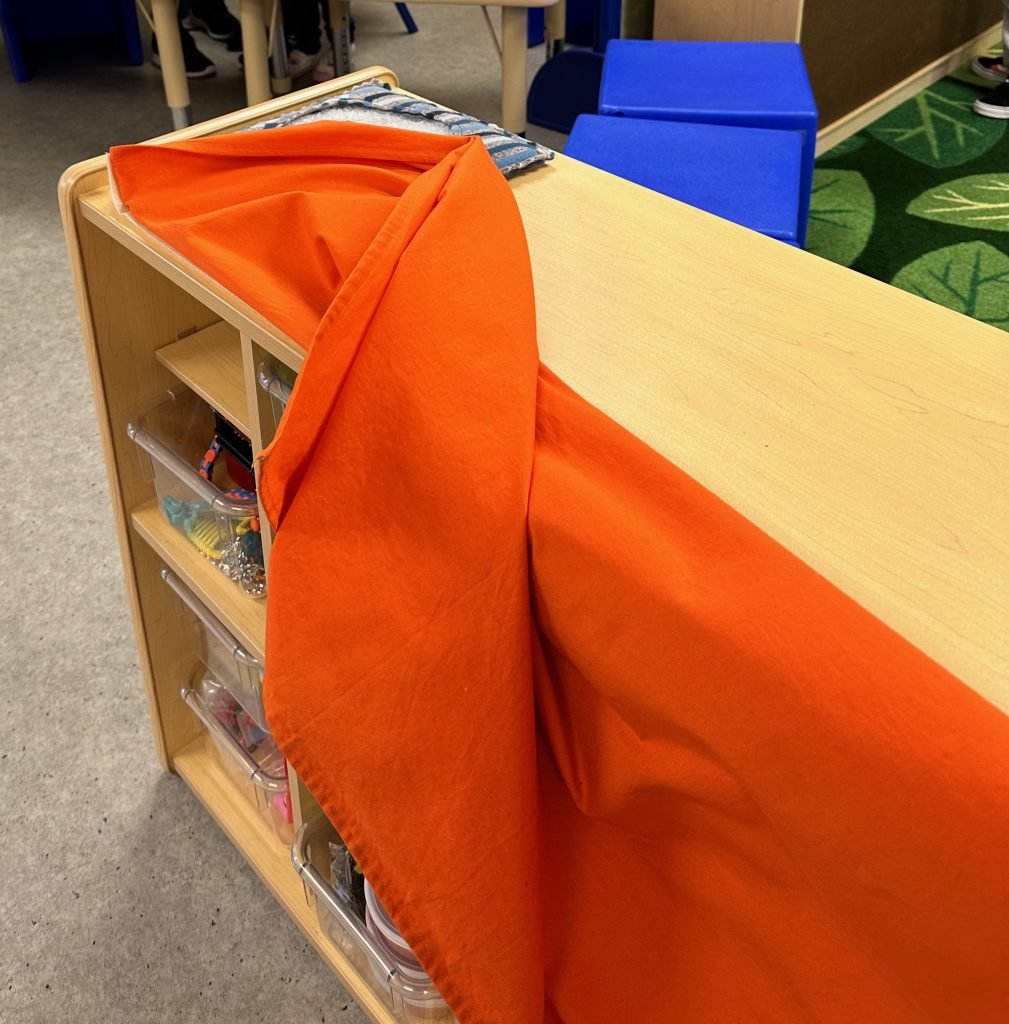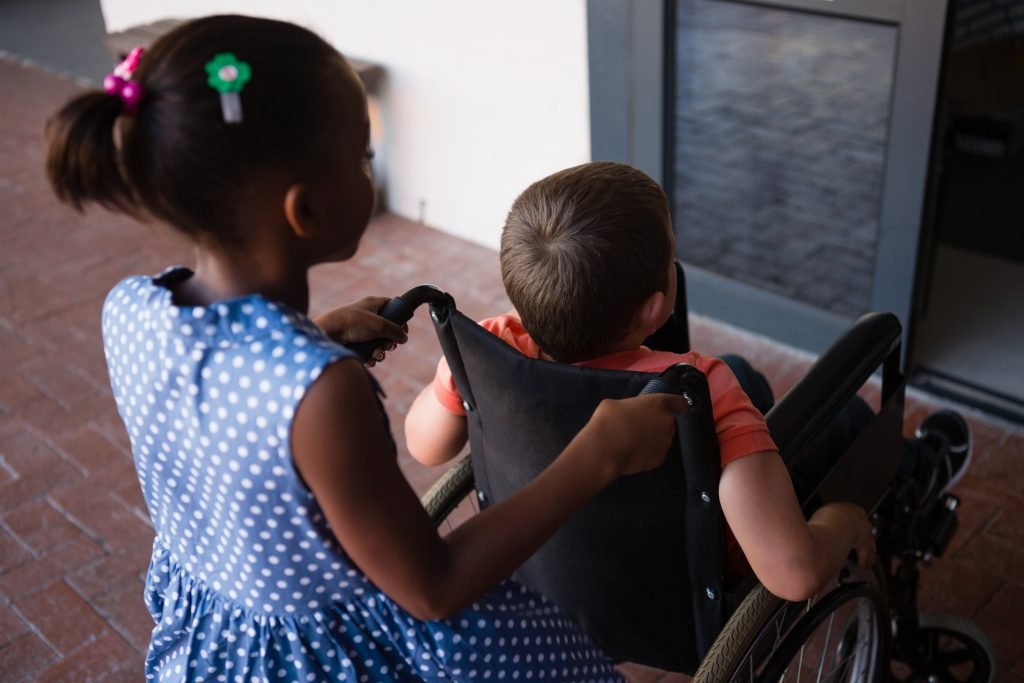Recently, I have immersed myself in understanding the meaning of inclusion and children’s engagement. While visiting early childhood programs, I noticed an emerging trend of covering shelves by turning them against the wall and blocking them with “Do Not Touch” tape or adding curtains to cover what is inside.

I ask myself: What do children feel and think when they see these practices?
Educators often tell me that they cover the shelves to prevent behavioral issues. I invite us to question the message children receive when the shelves are covered or out of limits and how it impacts children’s sense of belonging.
A sense of belonging is essential in increasing children’ engagment and preventing disruptive behavior. A child’s sense of belonging develops through responsive relationships and supportive environments. Leading with equity and inclusion means asking these questions:
- Are environments designed to promote the children’s engagement?
- Do children feel welcome? How?
- Do we build and nurture adult-child relationships equitably?
- Do we provide access to well-curated, engaging materials that promote children’s engagement at all times?
- Are shelves organized to promote independence and availability of materials at all times?
- Is the physical space designed to promote all children’s engagement, independence, choice, and agency?
- Is the temporal space (schedule, rituals, and routines) intended to create a sense of community and increase children’s engagement?
- Are transitions clearly defined to create a smooth flow throughout the day?
- Are children’s cultural values represented in the space?
- Am I providing all children stability, trust, compassion, and hope?
If not, how might this contribute to children’s behaviors that challenge adults?

Focusing on Children’s Engagment: Shifting Perspectives From Challenging Behaviors to Understanding Children’s Desire to Learn and Make Meaning.
Children are social beings and have an innate need to please and be liked by the adults who care for them. Early care and education are more than teaching academic skills and performative compliance. Children need educators who see them as competent, capable, and creative.
Educators who care and understand that children need to make meaning of their world and that they work hard to figure out where they belong and how to get along with others. Acceptance and understanding are essential elements in promoting children’s engagement. Prosocial behavior is learned when adults have enough empathy to understand and guide children with care and kindness. Focusing on Children’s engagement requires educators to be empathic and understanding.
Children show empathy as a genuine act. In other words, children can’t be coerced to demonstrate empathy and care. Even though this intrinsic type of caring may be our ultimate goal for children, caring must be modeled by adults as they demonstrate respect and empathy for all children.
Caring is not learned with artificial methods, such as giving a child a heart when they behave in ways the adult approves. Caring behaviors emerge more naturally when children attend an early childhood program with adults who care and create a sense of community where everyone belongs and is accepted for their unique characteristics. An environment that focuses on children’s engagement and not a prescribed curriculum or techniques designed to be performative will better support their development.

Caring behaviors are developed over time through the practice of continuous thoughtful interactions and children’s engagement. This means that children need multiple daily opportunities to practice caring for each other and their environment. They also need access to well-curated, engaging, interesting materials that offer them control over their learning. Closed shelves attract attention and send a message of distrust. Open shelves say, “Come and play and explore.” Children need to feel independent and trustworthy. When shelves are out of limits, children feel excluded and will find mistaken ways to let adults know they need attention.
Caring and empathetic classrooms are not created overnight or with simply one or two opportunities to practice caring. Caring classrooms are designed with a teaching team that constantly models and encourages kindness. Children must have naturally occurring opportunities to practice caring for each other. Genuine caring goes far beyond simple gestures to include more complex behaviors such as collaboration, generosity, empathy, and being able to take another’s perspective. Adults model these behaviors by listening to children’s questions and ideas and by designing spaces and places that create community, children’s engagement and belonging. When an environment promotes collaboration and trust, children are open to interacting with each other in more acceptable ways.

Designing a Caring and Empathic Ecosystem to Promote Children’s Engagement
The more children move, the more they learn. The more they use their senses, the more they know. A well-designed space will further support children’s learning by engaging them in self-sustained play. Contrary to what many believe, removing access to materials will not diminish mistaken behaviors. Instead, the lack of access to developmentally appropriate materials will increase unwanted behavior. The following guidelines will help educators make some decisions to redesign their early childhood ecosystem.
| Behavior | Possible Causes | Changes to the Environment |
|---|---|---|
| Running in the classroom. | Too much space is open, with no specific invitations to play; the room is not divided into small enough areas; exploration spaces are not well defined. Shelves are turned towards the walls, and curtains are used to limit access to materials. | Use shelves and furniture to divide the space. Avoid open spaces that encourage children to run. Create welcoming spaces where children can play alone or with others. Place furniture to create flow and movement. When furniture is placed against the wall, we create boxes that prevent traffic flow. Children enter and exit the space the same way. Creating multiple access pathways increases interactions and collaboration. |
Arguing over toys. | Too many popular (commercial) toys and books are one-of-a-kind, and children are asked to share them too often. Too many colorful items provoke children to argue over getting the desired color. | Provide unscripted materials that give children control over the action. Curate and play with the materials to ensure variety and complexity. When materials are more natural in color, they prevent children from arguing about using only specific colors. Decolorizing the space can facilitate collaboration focused on interaction and connections. |
| Wandering around and looking for an exploration that is engaging. Undefined play patterns. | The room is too cluttered; choices are unclear; there is not enough to do, and too much time is allocated to completing academic tasks or adult-designed crafts. | Get rid of clutter. Assess the wall noise and limit the use of color. Simplify the layout of the room and materials. Add more choices. Revisit the schedule and routines. Are there enough materials for children to play both individually and in collaboration? How is children’s engagement promoted? Design the temporal space to facilitate long periods of play. |
Becoming easily distracted. Moving from one exploration to the next. | Areas are undefined and open; children can see everything going on in the room; materials are too difficult, or children are bored with them. | Use shelves to define areas. Separate noisy and quiet areas. Assess children’s skills and select unscripted materials (Loose Parts) they can use in exciting ways. Asses what is on the wall. Too many commercial and colorful items can be distracting and add stress. |
Continually intruding on other’s workspace. | Space is limited; poor traffic patterns prevent children from spreading out. Most of the furniture is pushed against the wall. | Use shelving to define play areas for children. Trays and open frames on a table help define how many children can join in a specific activity. Trays and baskets help organize Loose Parts while making them accessible to children. |
Misusing materials and not contributing to organizing the space. | Children may be bored with toys that require specific responses. The materials do not offer complexity. The materials on shelves are messy and inaccessible. | Make a place for everything. Baskets help with organization. Provide consistent and caring guidance on how to clean up. Remember, children’s interest is not to clean up. However, they want to be part of a community, and they will help when they feel they belong. Remember. |
Another aspect of the physical environment includes the selection and placement of materials. Materials, such as Loose Parts, are developmentally appropriate and linguistically and culturally relevant for young children in the classroom. For example, the block area should include a variety of blocks to allow children with varying motor skills to manipulate them, and these materials should be placed so that they are easily accessed to engage children. Educators must also take care when it comes to:
- Organizing materials to promote independence.
- Providing enough materials within the centers allows children to be engaged and not argue over limited resources.
- Having spaces organized and ready to go when children arrive.
- Making sure the materials are developmentally appropriate and represent the diversity of the children.
- Layer for complexity and engagement.
- Providing unscripted materials that offer developmentally appropriate challenges promotes problem-solving skills growth.
- Designing the shelves to guide children to make decisions about materials.
- Rotating materials to promote children’s interest and keep the materials novel.


Your Turn!
Share:
How do you organize your ecosystem to engage children in play and children’s engagement?
How does the ecosystem create a sens of belonging, children’s engagement and empathy?